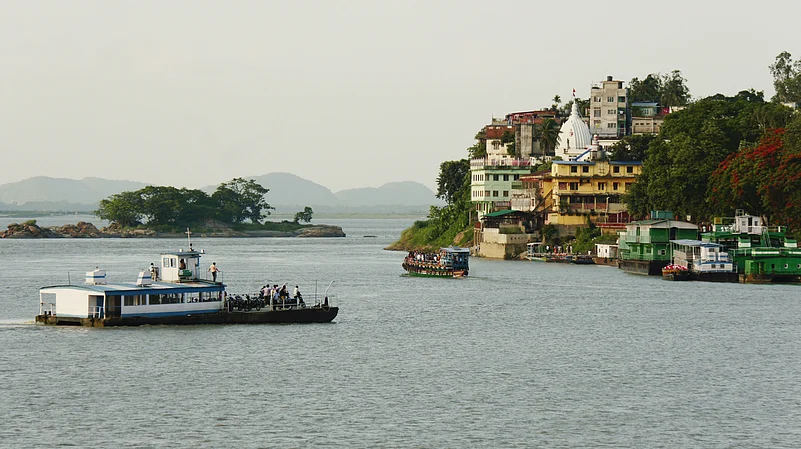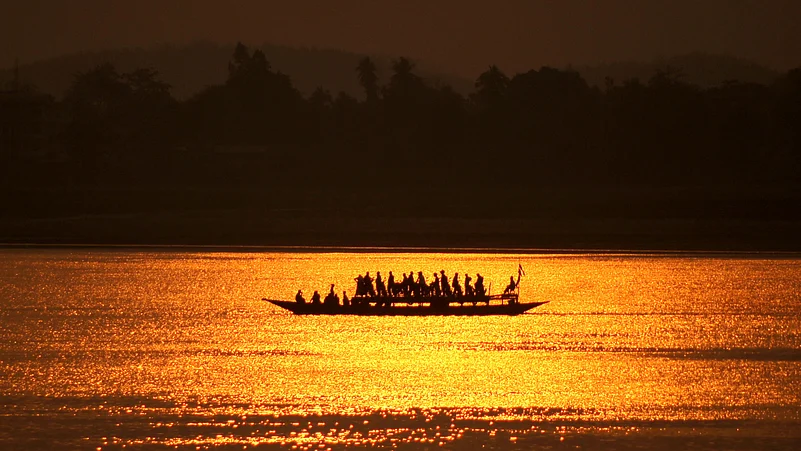China has initiated the construction of the $167.8bn Medog Dam on the Brahmaputra river in southeastern Tibet, close to the Indian border in Arunachal Pradesh.
Chinese Premier Li Qiang announced its launch at a groundbreaking ceremony held on the lower reaches of the Brahmaputra river, locally known as Yarlung Zangbo in China, at Nyingchi City, according to Chinese state news agency Xinhua.
The Brahmaputra is a major river system of the Central and South Asia region, flowing approximately 2,900 km from its source in the Himalayas through Tibet, India and Bangladesh. Of this length, around 1600 km is in Tibet, 900 km in India, and the remaining 400 km in Bangladesh. The river eventually merges with Ganges (Ganga) river and the mingled waters empty into the Bay of Bengal.

Originating from the Angsi glacier in northern Himalayas in Tibet, the Brahmaputra river is regionally known as Yarlung Zangbo in China. It flows eastwards across the Tibetan Plateau, then enters Arunachal Pradesh in India where it takes the name Siang or Dihang. As it progresses further downstream, through Assam, it takes on the name, Brahmaputra. Thereafter, the river flows into Bangladesh where it merges with Ganges (Padma) and later merges with the Meghna river before draining into the Bay of Bengal.
Famous for its abundant water resources, the river plays a key role in the ecology and cultures of the region it flows through.
Brahmaputra—A River Untamed
The Ganges-Brahmaputra river system has the third highest average discharge of the world’s rivers—roughly 1,086,500 cubic feet (30,770 cubic meters) per second, out of which approximately 700,000 cubic feet (19,800 cubic meters) per second of the total is supplied by the Brahmaputra alone.

The Brahmaputra river also has a tendency to flood every year. According to Britannica, the volume of water carried by the Brahmaputra in India and Bangladesh is enormous. In Assam, the river valley is surrounded by hill ranges on the north, east and south and receives more than 100 inches (2,540 mm) of rainfall annually, while in the Bengal Plain heavy rainfall—averaging 70 to 100 inches—is reinforced by the huge discharge of the Tista, Torsa and Jaldhaka rivers.
As a result, extensive flooding occurs annually in the Brahmaputra valley during the summer monsoon. Additionally, tidal surges accompanying tropical cyclones sweeping inland from the Bay of Bengal periodically bring great destruction to the delta region.
The river also holds cultural significance in Tibetan and Indian cultures. In the Tibetan culture, Yarlung Tsangpo represents the body of the goddess Dorje Phagmo, one of the highest incarnations in Tibetan culture. On the Indian side, the Brahmaputra, the only male river that literally translates as ‘Son of Brahma’, is revered in Hindu, Jain and Buddhist traditions.

According to data shared by the Government of Assam, the river slope is extremely steep until it enters India. A drop of about 4,800m is achieved in a length at about 1,700 km in China (Tibet). This average slope of about 2.82 m/km gets reduced to about 0.1m/km in Assam valley. Due to this sudden flattening of river slope, the river becomes braided in nature in the Assam valley. During its course in the Assam valley, from Kobo to Dhubri, the river is joined by about 20 important tributaries on its North bank and 13 on its South bank. Joining of these tributaries brings high sediment load, which in turn activates braiding.
The steep drop in Tibet and Arunachal Pradesh causes accelerated flow of water and increases erosion, making the river dangerous during flash floods.
The dramatic flattening downstream leads to large sediment deposits, creating a braided river channel that frequently changes course—intensifying floods and erosion risks in Assam.
Damming the Brahmaputra
The project to build dams on the Brahmaputra was approved by Beijing in December 2024 and is linked to China’s carbon neutrality targets and development goals in the Tibet region. The dam will consist of five cascade hydropower stations with a combined capacity to produce 300bn kilowatt-hours of electricity annually—equivalent to the amount consumed by Britain in 2024, according to Reuters.
“The electricity generated will be primarily transmitted to other regions for consumption while also meeting local power needs in Tibet,” Xinhua reported after the ceremony in Nyingchi, a region close to Arunachal Pradesh.
While this appears to be a positive step towards green energy generation, there are underlying issues that India and Bangladesh have already raised, which could potentially impact millions of people downstream. NGOs have also warned of risks to one of the richest and most diverse environments on the Tibetan Plateau.
According to reports, the construction of the Brahmaputra dam is expected to take approximately 10 years. “Assuming 10 years of construction, the investment/GDP boost could reach 120bn yuan ($16.7bn) for a single year,” stated global bank Citi, as cited by Reuters in a July 21 report. “The actual economic benefits could go beyond that,” it added.

China’s move to construct a massive dam on the Brahmaputra violates the UN Watercourses Convention, 1997, which mandates prior notification or consultation with downstream countries like India. This undermines the spirit of cooperation outlined in the existing MoUs, which lack stringent enforcement mechanisms. As a result, China can selectively withhold information during critical times, such as dam-induced floods or landslides that may impact lower riparian regions.
UN General Assembly Resolution 62/68 of 2007 states that a state of origin must prevent transboundary harm through precautionary measures and environmental impact assessments. In case of such damage, the state is liable to mitigate the disaster and provide compensation.
Ecologically Fragile
Having already exploited much of its internal rivers, China is now focusing on transboundary ones. It aims to peak carbon emissions by 2030 and achieve carbon neutrality by 2060. The proposed dam is part of its 14th Five-Year Plan (2021–2025) and Long-Term Goals 2035. To reach these targets, the Chinese government is emphasising renewable energy, particularly hydropower.
However, this focus on transboundary rivers—especially the Brahmaputra basin—raises serious concerns for downstream countries like India and Bangladesh. The site identified for dam construction is among the world’s most seismically active regions.

According to The New Indian Express, the Himalayan thrust, trans-Himalayan faults and Yarlung Zangbo suture zone face increasing stress from population growth, climate change, shifting consumption patterns and the drive for hydroelectric power to meet green energy targets. A report by the United States Geological Survey noted that the region is historically prone to seismic activity—the 1950 Assam-Tibet earthquake of 8.6 magnitude underlined the area's vulnerability to major hazards.
Despite existing MoUs and the Expert-Level Mechanism established in 2006, India and China do not have a formal water-sharing treaty for trans-border rivers. Therefore, transboundary cooperation, real-time hydrological data sharing and thorough environmental impact assessments are critical to ensure ecological balance and the sustainable flow of the river.
Geopolitically Fraught
Another controversial project built by China at a similarly large scale was the Three Gorges Dam on the Yangtze river which originates from the Tanggula Mountains on the Qinghai-Tibet Plateau in Qinghai province, western China, as stated by Britannica. The river flows eastward across China, passing through provinces such as Sichuan, Hubei, Anhui and Jiangsu, before emptying into the East China Sea near Shanghai.
Known as the third longest river in the world, the Yangtze river is the longest river in both China and Asia. According to World Wildlife Fund (WWF), it spans 6,300km, flowing across more than halfway of China. Its basin covers around 1.8 million sq km, accounting for almost one- fifth of China's land area.
The largest hydropower project on it was built in 1994, designed to generate electricity and, by taming China’s longest river, shield millions of people from deadly floods. Contrary to the proposed outcomes, the project took nearly two decades to complete, used over 200bn yuan and displaced about 4mn residents.
Moreover, more than 158 people died or went missing in the devastating floods in 2020, while 3.67 million residents were displaced and 54.8mn were affected in all. Economic losses were estimated at 144bn yuan ($20.5bn), according to CNN.

After China’s first official announcement of its plan to construct the dam on Brahmaputra in 2020, officials in New Delhi started considering a counter-dam to “mitigate the adverse impact of the Chinese dam projects”. According to Al Jazeera, the Indian government proposed building the Siang dam, a hydropower project in Arunachal Pradesh which would create a large reservoir to offset disruptions in the flow of the river caused by the upcoming Medog dam on the Chinese side and safeguard downstream areas against flash floods or water scarcity.
But the presence of two giant dams in the Himalayan region—with a fragile ecosystem and a history of devastating floods and earthquakes—poses serious threats to millions of people who live there and further downstream, caution experts and climate activists. In all, indigenous communities living in these ecologically vulnerable regions lie at the receiving end of any miscalculation over natural resources in this sensitive region.































